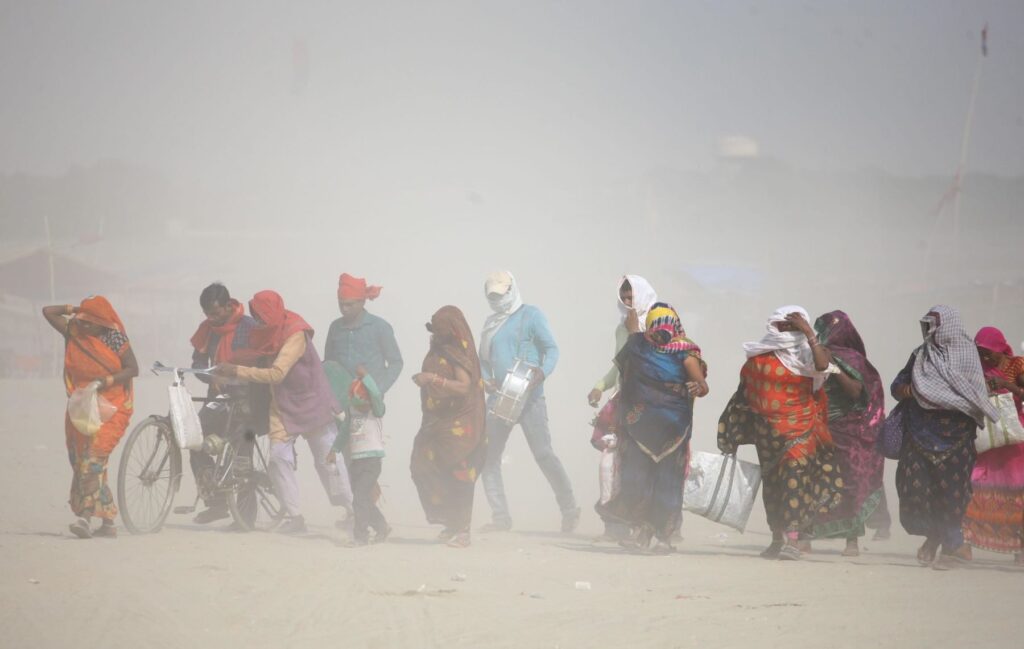Medical Processes Hide True Number Of Indians Dying From Extreme Heat
Jul 7, 2023 | Pratirodh Bureau
Workers commute during heatwave conditions in Prayagraj, Uttar Pradesh, on 7 June 2022. This year, the state has suffered extreme heat once again (Image: Ritesh Shukla/Alamy)
Between 15 and 22 June this year, more than 150 people died in two hospitals in Ballia and Deoria districts, in north India’s Uttar Pradesh state. In this period, temperatures in Ballia neared 45 degrees Celsius, with a relative humidity of 30-50%. According to the National Oceanic and Atmospheric Administration’s Heat Index Calculator, these conditions would feel like more than 60˚C to the human body – indicating extreme danger. The India Meteorological Department had earlier issued warnings that heatwave conditions were “very likely”.
A state minister reportedly said that the heatwave was one of the reasons for the spike in deaths in Ballia and Deoria. An investigative team that was sent to Ballia concluded that heat could have contributed to the deaths, but was not “causative”, noting that most patients had underlying health issues. This has raised the question of how India records the health impact of extreme heat, a key facet of climate change in the country.
“Birth and death systems in the country are not organised,” Dileep Mavalankar, director of educational establishment the Indian Institute of Public Health, told The Third Pole. “The government’s lack of interest in recording excess mortality points towards a flawed death management system.”
“During the 2003 heatwave in Europe, 70,000 additional deaths were recorded in just three weeks. But not all were directly linked to the heat,” Mavalankar added. “Similar things happened in Ballia and Deoria this year, where excess mortality was recorded but no reason was given.”
On 20 June, India’s health minister Mansukh Mandaviya announced that the Indian Council for Medical Research will conduct research into minimising the impacts of heatwaves on public health.
How Are Deaths From Heat Determined In India?
Rakesh Parashar, a medical doctor and health policy advisor who works with the World Health Organization and World Bank programmes, explained that in India, death certificates can list both an immediate cause of death and ‘antecedent’ and ‘preceding’ causes – underlying issues or conditions which led or contributed to the ultimate cause of death.
“Death certificate rules ask [doctors] to mention immediate medical causes such as ischaemic heart disease [reduced blood flow to heart] or acute kidney failure, which may be precipitated by heat exposure or heat stroke in some people, especially in the elderly and diabetics,” said Parashar. “Thus, heat exposure can be a contributory or a preceding factor in death.”
“Heat can exaggerate cardiac events, especially in the elderly, and that is completely missing [in heat mortality data], as heat mortality data captures mostly the deaths because of heat stroke or suspected heat stroke,” Parashar explained. “In UP’s case, it could be ignoring the contribution of heat to the cardiovascular deaths and missing out on correctly identifying heat stroke, leading to denial [of the role of extreme heat in several deaths].”
A lack of clarity around recording the role of heat is reflected in major discrepancies between data on ‘heat deaths’ collated by different government agencies in India. According to a report published in 2021 by India’s National Disaster Management Authority, only four people died due to heatwaves in 2020. However, the National Crime Records Bureau (NCRB), which collects data on deaths from ‘forces of nature’, recorded 530 deaths from “heat/sun stroke” in the same year.
Determining the role of extreme heat in causing a death can be very challenging. Laboratory tests can detect organ damage caused as a result of heat stroke, and a combination of tests can determine the impact of hyperthermia (high body temperature) on the central nervous system, but no single test can identify extreme heat as a cause of death.
Malavankar told The Third Pole that properly investigating a public health crisis involving extreme heat, such as that experienced in Uttar Pradesh, requires post-mortems to be conducted, with health statisticians and epidemiologists surveying the data. But in Ballia’s case, he says, the investigative team was led by the head of the National Centre for Disease Control, which mainly deals with communicable diseases.
Heatwaves Set To Get Worse In India With Climate Change
An India Meteorological Department report from April 2023 states that heat waves have already intensified in India, increasing by an average of one day per decade between 1961 and 2020. “There are long-term increasing trends of heat wave frequency, duration and maximum duration over northwest India,” the report says.
Such events are set to get yet more frequent and severe due to climate change. India’s National Action Plan on Heat Related Illness, published by the health ministry, states that “Climate Change is expected to increase the Heatwave frequency (HWF) and Heatwave duration (HWD) in India by 0.5 events per decade and 4-7 days per decade, respectively.”
Climate change is also likely to cause an increase in wet-bulb temperatures in India, which take into account the combined effect of humidity and air temperature. High wet-bulb temperatures feel much hotter for the human body, and are much more dangerous.
“Heatwaves have already intensified over India. This is in response to the 1°C change in global mean temperatures [which has already occurred]”, said Roxy Matthew Koll, a climate scientist at the Indian Institute of Tropical Meteorology. “Global warming is projected to cross 2°C by 2050, and the heatwaves by then will be much more intense, frequent, and cover larger areas,” Koll added.
“We should resolve this issue [of accurately recording the role of extreme heat in causing deaths] since it is quite difficult for us climate scientists to work on the link between heatwaves and heat stroke/mortality without this data,” Koll said.
(Published under Creative Commons from The Third Pole. Read the original article here)
